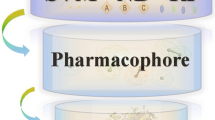Abstract
A reliable 3-D structure of Triacylglycerol lipase from Bacillus thermocatenulanatus was constructed by homology modeling. Under molecular dynamics simulation, it was refined and checked. The model was further used as a receptor to search binding sites and carry out flexible docking with a range of substrates, whose enzyme activities were already measured. By inputting a series of docking results, virtual substrates screening models were established and assessed. Monadic nonlinear solution demanded less data but was weak in fitting enzyme activity data with little difference; its mean absolute percentage error (MAPE) of regression was 0.67 and mean square error (MSE) was 1.73 U/mg. Both quadratic stepwise regression and BP neural network were good in regression and prediction; however, more data were required. In the cross-validation of 12 groups, overall MAPE of regression and prediction for the former were 0.18 and 0.49, while the latter was 0.55 and 0.36. MSE values for these two methods were 0.95 and 1.20 U/mg, respectively. Therefore, monadic nonlinear regression model can be used as a preliminary screening one; quadratic stepwise regression and BP neural network approach can be applied to precise screening.
Similar content being viewed by others
References
Jaeger K E, Dijkstra B W, Reetz M T. Bacterial biocatalysts: molecular biology, three-dimensional structures, and biotechnological applications of lipases [J]. Annu Rev Microbiol, 1999, 53: 315–351.
Rua M L, Schmidt-Dannert C, Wahl S, et al. Thermoalkalophilic lipase of Bacillus thermocatenulatus large-scale production, purification and properties: aggregation behaviour and its effect on activity [J]. J Biotechnol, 1997, 56: 89–102.
Liu M F, Somers N A, Kazlauskas R J, et al. Mapping the substrate selectivity of new hydrolases using colorimetric screening: lipases from Bacillus thermocatenulatus and Ophiostoma piliferum, esterases from Pseudomonas fluorescens and Streptomyces diastatochromogenes [J]. Tetrahedron: Asymmetry, 2001, 12: 545–556.
Brooijmans N, Kuntz I D. Molecular recognition and docking algorithms [J]. Annu Rev Biophys Biomol Struct, 2003, 32: 335–373.
Wein T, Wanner K T. Generation of a 3D model for human GABA transporter hGAT-1 using molecular modeling and investigation of the binding of GABA [J]. J Mol Model, 2010, 16: 155–161.
Chu H Y, Zheng Q C, Zhao Y S et al. Homology modeling and molecular dynamics study on N-acetylneura-minate lyase [J]. J Mol Model, 2009, 15: 323–328.
Wada M, Hsu C C, Franke D, et al. Directed evolution of N-acetylneuraminic acid aldolase to catalyze enantiomeric aldol reactions [J]. Bioorg Med Chem, 2003, 11: 2091–2098.
Miguet L, Zervosen A, Gerards T, et al. Discovery of new inhibitors of resistant streptococcus pneumoniae penicillin binding protein (PBP) 2x by structure-based virtual screening [J]. J Med Chem, 2009, 52: 5926–5936.
Kryger L. Interpretation of analytical chemical information by pattern recognition methods—A survey [J]. Talanta, 1981, 28: 871–887.
Livingstone D J. Pattern recognition methods in rational drug design [J]. Methods Enzymol, 1991, 203: 613–638.
Alonso H, Bliznyuk A A, Gready J E. Combining docking and molecular dynamic simulations in drug design [J]. Medicinal Research Reviews, 2006, 26: 531–568.
Sali A, Overington J P. Derivation of rules for comparative protein modeling from a database of protein structure alignments [J]. Protein Sci, 1994, 3: 1582–1596.
Laskowski R A, Moss D S, Thornton J M. Main-chain bond lengths and bond angles in protein structures [J]. J Mol Biol, 1993, 231: 1049–1067.
Morris A L, Macarthur M W, Hutchinson E G, et al. Stereochemical quality of protein structure coordinates [J]. Proteins, 1992, 12: 345–364.
Molegro ApS. Molegro Virtual Docker, 3.0.0. [ET/OL]. [2009-11-26]. http://www.molegro.com/mvd-product.php.
Gehlhaar D K, Verkhivker G M, Rejto P A, et al. Molecular recognition of the inhibitor AG-1343 by HIV-1 protease: conformationally flexible docking by evolutionary programming [J]. Chem Biol, 1995, 2: 317–324.
Yang J M, Chen C C. GEMDOCK: A generic evolutionary method for molecular docking [J]. Proteins, 2004, 55: 288–304.
Jeong S T, Kim H K, Kim S J, et al. Novel zinc-binding center and a temperature switch in the Bacillus stearothermophilus L1 lipase [J]. J Biol Chem, 2002, 277: 17041–17047.
Matsumura H, Yamamoto T, Leow T C, et al. Novel cation-pi interaction revealed by crystal structure of thermoalkalophilic lipase [J]. Proteins, 2008, 70: 592–598.
Eisenhaber F, Persson B, Argos P. Protein structure prediction: recognition of primary, secondary, and tertiary structural features from amino acid sequence [J]. Critical Reviews in Biochemistry and Molecular Biology, 1995, 30: 1–94.
Koziel S, Michalewicz Z. Evolutionary algorithms, homomorphous mappings, and constrained parameter optimization [J]. Evol Comput, 1999, 7: 19–44.
Author information
Authors and Affiliations
Corresponding author
Additional information
Foundation item: Supported by the Research Found for Doctoral Foundation of Institutions of Higher Education of China (20070385001)
Biography: LI Wei, male, Master candidate, research direction: enzyme and bioinformatics.
Rights and permissions
About this article
Cite this article
Li, W., Li, H. & Fang, B. Virtual substrates screening model of triacylglycerol lipase from Bacillus thermocatenulanatus . Wuhan Univ. J. Nat. Sci. 16, 106–112 (2011). https://doi.org/10.1007/s11859-011-0720-4
Received:
Published:
Issue Date:
DOI: https://doi.org/10.1007/s11859-011-0720-4




